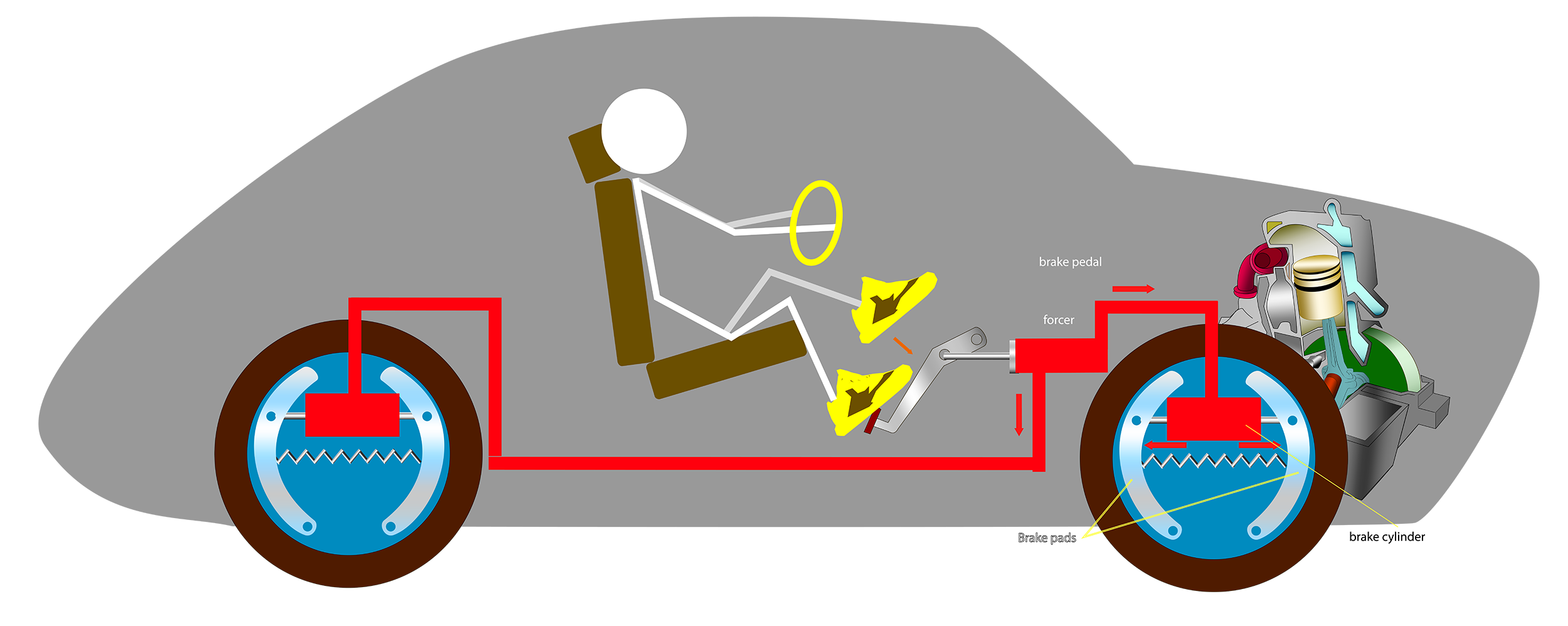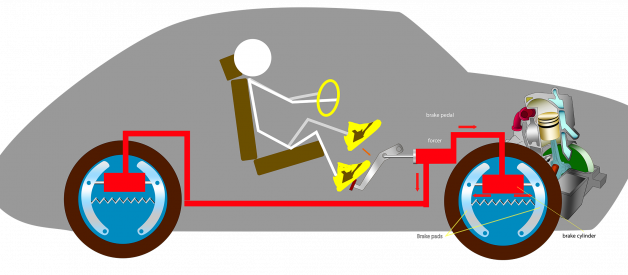By Mike Ales
 Car Braking System
Car Braking System
Sterling, Virginia ? Have you noticed that your car slows down when you let off the gas pedal even before you hit the brakes? Part of the reason you slow down when you lift your foot is because your engine is no longer receiving the fuel it needs to maintain its speed. But there is more going on: a phenomenon called engine braking. But what is engine braking and is it good or bad for your car?
How engine braking works
Engine braking is the process of letting your engine assist in slowing down your car, truck, or SUV. Many drivers use varying degrees of engine braking to control the speed of their vehicles.
But how does engine braking work?
Imagine a toddler pedaling a tricycle. As long as he is pedaling, the trike moves. On the other hand, if he stops pedaling and keeps his feet on the pedals, his legs (instead of providing propulsion) will offer resistance and slow down the tricycle.
In a similar fashion, your car?s engine does the same thing. When you release the gas pedal, you essentially close off the throttle, creating a vacuum inside your engine that (along with friction from all the moving parts) increases resistance and lowers engine speed, or RPMs. This resistance in your engine is transferred through the drivetrain (the transmission, axles, etc.) to the wheels.
Along with the rolling resistance of your tires against the pavement, engine braking slows down your vehicle naturally. Every time you let off the gas pedal, your engine automatically serves to slow you down. If you shift into lower gears in the process, your engine?s tendency to slow down will intensify the effect of engine braking. This is pretty common for drivers of cars with manual transmissions as they downshift when slowing or coming to a stop. The engine will rev up with each shift to a lower gear and then put a drag on the drivetrain as the RPMs come down. While the effects of engine braking are generally more pronounced on a car with a manual transmission, they can also be utilized on a vehicle with an automatic transmission.
Why would you use engine braking?
Perhaps the most common use of engine braking is to assist your brakes when driving downhill. If you find yourself descending a long slope on the road, you may have the tendency to ?ride the brakes? to keep your speed in check. But there are problems with constant braking downhill.
First of all, you will wear out your brake pads more quickly. Brake pads contain friction material designed to convert the kinetic energy of your vehicle-in-motion to friction that slows and stops your car. That friction material wears down over time. That?s why brake pad replacement is a routine maintenance item. But too much friction during downhill braking causes the brake pads to wear faster. It also creates a lot of heat that can damage the brake system. The brake rotors that your brake pads grab onto can overheat and warp, and the brake fluid can boil and cause problems throughout the system.
Additionally, a condition known as ?brake fade? can occur. This is where you ride the brakes continually down a hill and the brake system is no longer to manage the heat that is produced. As the brakes heat up, the effectiveness of the brake system decreases, and so does your ability to slow down. That is why some road ways have designated runaway truck lanes in hilly areas. The larger the vehicle, the more difficult it is to brake going downhill.
So, to assist your brake system when going downhill, you might choose to employ engine braking the way many truckers do with their big rigs.
Other instances where engine braking can be a benefit include slowing down in traffic and maintaining control on wet, snowy, or slippery roads. Why might you choose to use engine braking in these cases? Well, one, the life of your brake system can be increased. Also, because you let off the throttle, fuel savings can increase. And by avoiding too much pressure on the brakes you can avoid locking up your tires, helping you keep better control in slippery situations.
When should you avoid engine braking?
Engine braking is a useful technique to save on brake system wear, to maintain vehicle control, and to safely descend hills. It is frequently used with manual transmissions. It can be applied, albeit with somewhat less effect, with automatic transmissions. But care should be taken to ensure that engine braking is not used too aggressively.
To make full use of engine braking, a driver will usually shift from a high gear to a lower gear as the vehicle slows down. This practice increases the effectiveness of the technique. But shifting at too high an engine speed (RPMs) or jumping to too low a gear can put a great deal of strain on the drivetrain, especially the clutch and transmission. Too much applied force from a sudden drastic shift can also cause premature engine wear.
Care must also be taken to allow for plenty of room on the road ahead for a safe, assured stopping distance. Reduced brake system wear, increased fuel economy, and improved vehicle control are sound reasons to use engine braking. But engine braking alone is not sufficient to control your car. Engine braking is designed to be used in conjunction with your brakes ? not instead of them.
Why is engine braking prohibited in some areas?
You may have seen signs, usually in residential areas, that read, ?Engine braking prohibited?, and wondered why you aren?t allowed to downshift. Well, to understand why the sign is posted, it is necessary to distinguish between types of engine braking.
In a nutshell, your passenger car (as already stated) relies on the vacuum created inside your engine to add resistance all the way to your wheels. On a semi truck with a big diesel engine, the process works a little differently. A compression release, known as a ?Jake brake?, opens the exhaust valves at the top of the compression stroke, creating a lot of force in the engine to aid in slowing down the truck. This process creates a really loud noise like gunfire or backfire. In some locations, the practice is prohibited simply to reduce the noise.
My vehicle has Downhill Assist Control ? Is that the same as engine braking?
Downhill Assist Control (DAC) or Hill Assist Control (HAC) is a feature on some vehicles, usually trucks or SUVs, that allows a driver to descend a steep hill without pressing on the brake pedal. While DAC is similar to engine braking, the way it happens is a little different. First of all, DAC is used when going down a steep slope. It is also an automatic process; you do not use the brakes manually. DAC is also used at low speeds (15?20 mph or less) and is designed to help your vehicle maintain traction while maintaining its speed. DAC calls on the Antilock Brake System (ABS) to control the brakes for each wheel individually, and possibly Traction Control System to control the engine speed. If you try to manipulate the brake or gas pedal manually, you will override the DAC.
Should I use engine braking with my car?
So, should you employ engine braking? Sure. Some may argue that engine braking can cause damage to your car. Well, that is true if you abuse it. Make sure to use it properly. Avoid downshifting at high speeds. Shift only one gear at a time as your car is slowing down. Brake when necessary to allow the engine and brake system to work in tandem. When the car slows down, shift again until you are at your desired speed, where the engine speed keeps your car at the speed you want. Engine braking can save on fuel and maintenance costs. It can also keep you safer on downhill descents. Let your vehicle systems work in synergy and you will allow them to perform better.
Hogan & Sons Tire and Auto | Author: Mike Ales | Copyright April 2019
This article is intended only as a general guidance document and relying on its material is at your sole risk. By using this general guidance document, you agree to defend, indemnify and hold harmless Hogan & Sons Tire and Auto and its affiliates from and against any and all claims, damages, costs and expenses, including attorneys? fees, arising from or related to your use of this guidance document. To the extent fully permissible under applicable law, Hogan & Sons Tire and Auto makes no representations or warranties of any kind, express or implied, as to the information, content, or materials included in this document. This reservation of rights is intended to be only as broad and inclusive as is permitted by the laws of your State of residence.

